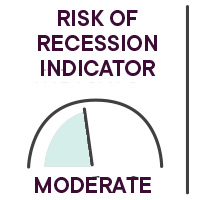Yann Furic
B.B.A., M. Sc., CFA®
Senior Portfolio Manager, Asset Allocation and Alternative Strategies
A euphoric month
The month of November kicked off the U.S. election. Former vice-president Joe Biden was elected, but the “blue wave” did not materialize.
The Democrats lost seats in the House of Representatives and failed to gain control of the Senate. The situation could change if the Republicans lose the two seats that are up for grabs in the Senate in the runoff elections on January 5 in Georgia.
Favourable perception
The outcome of the election was well received by the markets, which saw it as a change of tone for the U.S. administration. With a Republican majority Senate, the Democrats will not, however, be able to implement the measures put forward during their election campaign, including raising taxes on large corporations.
Vaccines on the horizon
On Monday, November 9, the Pfizer-BioNTech consortium released very encouraging results regarding the efficacy of its vaccine. This news propelled the markets upwards and, in particular, all sectors benefiting from a reopening of the economy. The following weeks saw the announcement of equally positive news for the Moderna and Oxford-AstraZeneca vaccines.
Back to normal? Not yet…
The availability of vaccines and how quickly people are vaccinated will dictate the return to normal, which may differ from country to country.
Meanwhile, the impending expiry of several wage subsidy programs for individuals and businesses could raise the unemployment rate and erode consumer confidence, which could slow the recovery.
Focus on the past month

Overview of global equity markets*
- The flagship index of the Canadian stock market, the S&P/TSX, rose 10.6% in November, for a return of 3.8% for the first 11 months of 2020.
- In the United States, the S&P 500 gained 7.9% and the Nasdaq, 8.9%, bringing their returns for the year to 14% and 37.2%, respectively.
- International stock markets were also in positive territory during the month, with the EAFE index climbing 12.4% for a year-to-date return of 3.5%.
- Emerging market equities rose 6.9% in November (+10.5% in 2020) and Chinese stocks were almost unchanged, losing only 0.03% (+26.1% in 2020).
* All the percentages in this section are in Canadian dollars. Bloomberg unless otherwise indicated.
Key events

COVID-19: finding a balance
The economic repercussions of the targeted closures of certain industries (tourism, recreation) are being felt globally, despite numerous attempts by governments to support their economy and their workers. Some measures have been renewed in Canada, while in the United States, no agreement has yet been reached. Discussions continue, albeit chaotically, between the various government bodies involved.
As President-elect Joe Biden will not take power until the inauguration of January 20, 2021, the possibility of a fiscal stimulus remains low, except in the event of a significant worsening of the pandemic, which could prompt the U.S. Senate to react.
Key rates still low
Global central banks are continuing their accommodative monetary policies and keeping key rates very low. This context is expected to remain unchanged until the economic recovery shows signs of more sustainable improvement.
Employment situation
Job creation was positive in Canada, but disappointing in the United States:
- 62,100 jobs were created in Canada versus expectations of 20,000, reducing the unemployment rate from 8.9% to 8.5%.
- South of the border, 245,000 jobs were created, short of the 460,000 expected, bringing the jobless rate to 6.7%.
Once again, monthly job creation decelerated, signalling a slower recovery.
Results – Canadian bonds
Government of Canada bonds across maturities posted a positive return of 0.2% for the month. They have risen 7.1% since the start of 2020. (Source: Canaccord Genuity)

Our strategic monitoring
Main risks
Here are some risks that we are closely monitoring in the current environment.
- The risk of a second economic slowdown, following the return of widespread lockdown measures in response to a second wave, as well as declining consumer confidence, could lead to reduced spending in the medium term.
- The results of the senatorial elections of January 5, 2021 in Georgia: In the unlikely event of the election of two Democratic senators, this would tip the Senate majority to the Democrats.
- The unresolved trade disputes between China and the United States continue to pose a risk to the global economy.
Fundamental indicators
Certain economic indicators moved in November.
Consumer confidence ![]()
The consumer confidence index fell below 100, after two more encouraging months. U.S. consumers are not seeing any real improvement in their economy or the job market. The steady rise in COVID-19 cases and the associated death rate are weighing heavily on Americans’ confidence in their economy.
Global Purchasing Managers’ Index ![]()
The index is at 53.7, up significantly from previous years, indicating an increase in purchasing managers’ intentions. Overall, most countries are seeing a rise in purchase intentions in the manufacturing sector, but the signals are less evident in the services sector, which has been harder hit by the health crisis.
U.S. retail inventory-to-sales ratio ![]()
This ratio is still at a 15-year low. The slowdown or stoppage of production of many goods during the pandemic contrasted sharply with the increase in sales (especially online) of many products. The resumption of production to rebuild inventories is a positive sign.
Benchmark rates in Canada, Europe and the United States ![]()
Rates remain at low levels, which is favourable for an economic recovery, and central banks stand ready to step in. Rates are expected to remain at low levels until economies return to sustained and prolonged growth.
François Landry
CFA®
Vice-President and Chief Investment Officer
Vice-Chairman of the Board of Directors of Professionals' Financial - Private Management
Our strategies
(6-to-12 month horizon)
Financial markets had an excellent November following the results of the U.S. election and news of the imminent arrival of vaccines. The Democrats’ winning of the presidency, coupled with the confirmation of a Republican majority in the Senate, as well as the drop in interest rates the day after the election, prompted us to increase the weighting of equities from 55% to 65%, and reduce the weighting of bonds from 45% to 35%, in our FDP Tactical Asset Allocation Private Portfolio. We believe that over a six to twelve month horizon, equity returns will be higher than bond returns.
There was little change in the geographic allocation of equities in our portfolios.
- The weighting of Canadian equities was slightly increased, with a higher weighting of Canadian banking stocks.
- We are neutral on U.S. equities. We maintained our exposure to technology stocks and increased our exposure to industrial products, which should benefit from announced infrastructure spending and the global economic recovery.
- We are neutral on EAFE (Europe, Australasia, Far East) equities due to the fiscal measures implemented in Europe and the return to partial lockdown of euro zone economies.
- We remain neutral on emerging market equities.
François Landry, CFA
Vice-President and Chief Investment Officer
Yann Furic, B.B.A., M. Sc., CFA
Senior Portfolio Manager, Asset Allocation and Alternative Strategies
Sources: Bloomberg
The opinions expressed here and on the next page do not necessarily represent the views of Professionals’ Financial. The information contained herein has been obtained from sources deemed reliable, but we do not guarantee the accuracy of this information, and it may be incomplete. The opinions expressed are based upon our analysis and interpretation of this information and are not to be construed as a recommendation. Please consult your Wealth Management Advisor.









